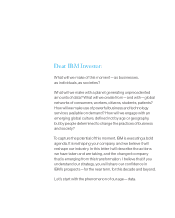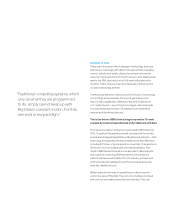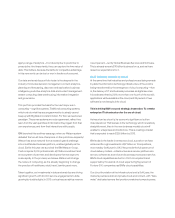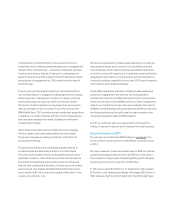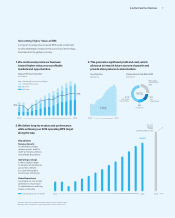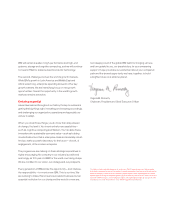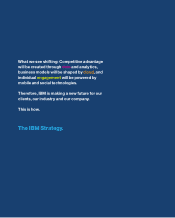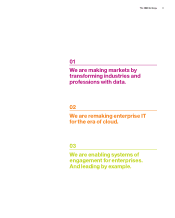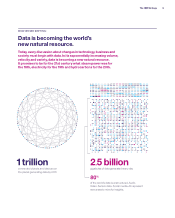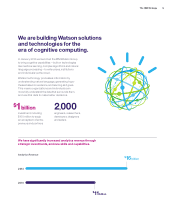IBM 2013 Annual Report Download - page 6
Download and view the complete annual report
Please find page 6 of the 2013 IBM annual report below. You can navigate through the pages in the report by either clicking on the pages listed below, or by using the keyword search tool below to find specific information within the annual report.deployed in real time, with hundreds of configuration options. Our
public cloud processes 5.5 million client transactions every day.
In terms of technology, security, flexibility and pricing, IBM surpasses
all our major competitors. And our rapidly growing roster of 30,000
client engagements—including companies like Honda, Sun Life
Stadium, US Open Tennis and hundreds of top online games with
a user base exceeding 100 million—is a testament to that.
These companies and a growing number of others understand
that their customer-facing applications—which they deploy on
public clouds for reasons of cost, accessibility and speed—must
be integrated with their core enterprise systems—such as finance,
inventory, manufacturing and human resources. This is why one
analyst predicts that by 2017, nearly 50 percent of large enterprises
will use hybrid cloud environments that are part public, part private
and integrated with back-end systems.
It is also why a new class of “cloud middleware services” is
emerging to manage these complex environments. Last month
we announced several capabilities that will connect enterprise
data and applications to the cloud. IBM’s entire enterprise
software portfolio is becoming available to developers in an open,
composable business environment to build applications with
flexibility and scalability. A “cloud first” approach is being
implemented in IBM software development labs globally.
For line-of-business users looking to drive innovation—including
heads of finance, marketing, human resources, procurement
and other functions—we offer an unmatched array of more than
100 software-as-a-service (SaaS) offerings. IBM’s SaaS offerings
today support 24 of the top 25 companies in the Fortune 500.
Going forward, companies will continue to unlock the value
of these business applications. For example, nearly 70 percent
of organizations are currently using or planning to use compos-
able business services.
Finally, enterprises will want—and need—to manage their data in
the cloud with the same rigor as if it were on-premises. Companies
will do this in order to ensure auditability, visibility, change control,
access control and data loss protection. Indeed, data manage-
ment will arguably be the single most important design point for
enterprise cloud environments, driven not only by security and
cost, but also by regulation.
To meet growing demand for greater speed, and legal requirements
for compliance and data residency, IBM is aggressively expanding
its global cloud footprint. We currently have 25 data centers globally,
and the new $1.2 billion investment announced in January will
see the opening of 15 more, in the US, the UK, Australia, Brazil,
Canada, China, France, Germany, India, Japan and Mexico.
The impact of our cloud investments shows up clearly in our
results. IBM’s cloud business grew 69 percent in 2013, delivering
$4.4 billion of revenue. As we actively embrace cloud in order
to deliver “IBM as a Service” to our clients, we expect to
see significant benefits in client experience, revenue growth
and enterprise productivity.
Engagement in a world of empowered individuals
The phenomena of data and cloud are changing the arena of
global business and society. At the same time, proliferating mobile
technology and the spread of social business are empowering
people with knowledge, enriching them through networks and
changing their expectations.
This leads to IBM’s third strategic imperative: To enable
“systems of engagement” for enterprises.


